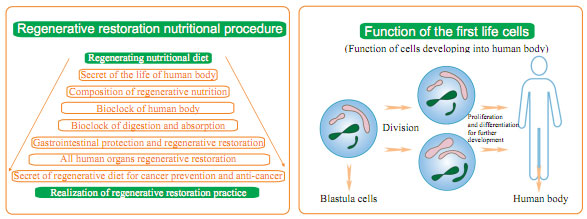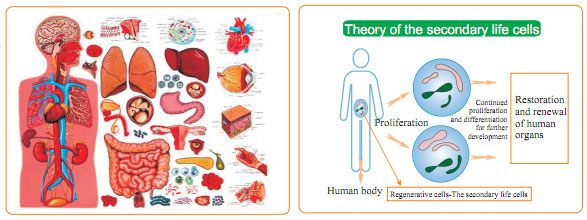Life basis of regenerative restoration
作者:Xu Rongxiang 出版社:CHINA SOCIAL SCIENCES PRESS 发行日期:2009 September

The basis of regenerative restoration refers to the secondary life potential of the human body. Since the merger of a sperm and an ovum into one cell, the zygote-derived cell will develop into a human being under certain life conditions and last until the end of the person’s life circle, which is the so-called first life of the cell. So where dose the secondary life cell come from? It is impossible from recombination of sperm and ovum, which would form a new human. Even the cloned human can not be considered as the original one. For years, we are making efforts to seek the clue of the existence of regenerative secondary life. If there is, then where is it? Finally, this long-chased vision was discovered in our medical practices in treating burns when we found the source of regeneration---the cells which could regenerate into new skin in deep burn wound. In 1980s, I proposed the theory that human body has the potential of regeneration. Though I claimed the theory mainly on skin regeneration, no one believed it at that time, and someone even blamed me as fraud. The opposing voice lasted for many years till the year of 2000 when the truth changed their mind. By then, we have already started the studies on regeneration of other organs based on the principle of skin regeneration. The studies were initiated by my assumption that it is possible to realize other organ regeneration if skin regeneration has come true. The first study is gastrointestinal (GI) tract regeneration. Considering GI tract and skin derived from two different embryonic germ layers, the success on GI tract regeneration indicates the possibility of regeneration of organs derived from the same germ layer. So based on the experience from the skin regeneration, I started the study on GI tract mucosa regeneration on the cell level, which was followed by the results of GI mucosa regeneration and restoration in aged gastrointestine within half a year. The success on GI tract regeneration is more significant than burn skin regeneration or even distal end finger regeneration, because GI tract can represent any internal organs based on their same origin in embryo, and GI tract regeneration means the possibility of all internal organ regeneration. We have been working on the GI tract regeneration procedure since early 1990s, and completed the first stage by 1997, and published our study results in 2000. Since 2002, we continued to extend the study from GI tract to 55 tissue organs. And in 2002, we made a press release titled as “life sciences explosion” when there were 30,000 relevant news reported on the day. Another five years was spent before all organ regeneration study was finished. Now, comprehensive human organ regeneration in situ is also completed.
It seems that our road to success is really easy and smooth. The reason was that we discovered the secondary life cells. The type of cells is the dormant copy cells reserved during cell division throughout the entire course of sperm and ovum merging and human body development, thus they can be considered as the identical twin brother of the first life cells. Such copy cells haven’t been found in lower animals which are not completely evolved and therefore have the regenerative potential. Higher animals have almost no regenerative potential because they are evolved completely, and only several simple parts still have regenerative potential like epithelial cell regeneration or hair regeneration from hair follicle. It is unbelievable to regenerate full-thickness skin concerning the above principle. Then what on earth is the mechanism behind skin regeneration? We observed the skin and found the karatin-19 cells which are the embryonic stem cells or ancestor cells of skin. But theoretically, embryonic cells will disappear after the course of development, how come could they emerge again? I explored further to seek the cells from which embryonic stem cells were derived. In respect of embryological standard, these stem cells should have their origin in blastula, which was proved impossible by our study and was excluded. During the continuous exploration, we found some cells did change and derive into such stem cells. We initially named these seed cells as Potential Regenerative Cells (PRCs). During further study, it was found that not all the cells in tissues had such regenerative potential, and actually, only a small amount of cells did, like intestinal mucosa which has few cells capable of further development. Because these cells are not exactly ‘stem cells’ in essence, we classify these cells as a type of copy cells which remain dormant during the course of development.









